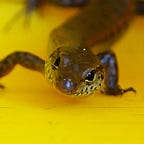Wrapped in a Rainbow
The hues of the lorikeet
With those vivid colouring-book hues, Rainbow Lorikeets (Trichoglossus moluccanus) should stand out like beacons. But when a bird lands in a tree, the green disappears among the leaves, the purple among the shadows, and the red and yellow are neutralised by reflected light. If it weren’t for the chatter and shrieks — and the deluge of discarded flowers — you might never know it was there.
But in the sunlight and against the rich cream of these palm flowers, the gaudiness and glamour are revealed. The colour patterns are the result of different evolutionary pressures — camouflage to hide from predators and fancy threads to attract mates. It is possible that the patterns have evolved as a mosaic, with the concealing green on the back and wings unchanging between Trichoglossus lorikeets (except for the exquisite wine-red Pohnpei Lorikeet T. rubiginosis) while neck, breast and belly colours are variations on a theme. To make things more complex, rainfall and humidity have an influence on the evolution of some colour patches. Pigments, especially melanin and psittacofulvin (unique to parrots), protect against feather-degrading bacteria, which can be a problem in wet tropical climates. Camouflage, attractiveness, and parasite-resistance is a lot to ask from feathers.
